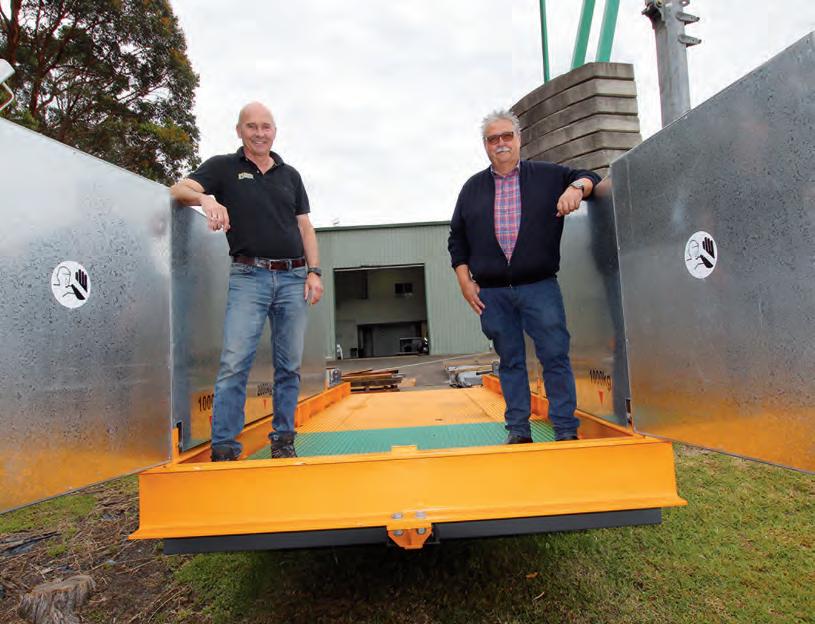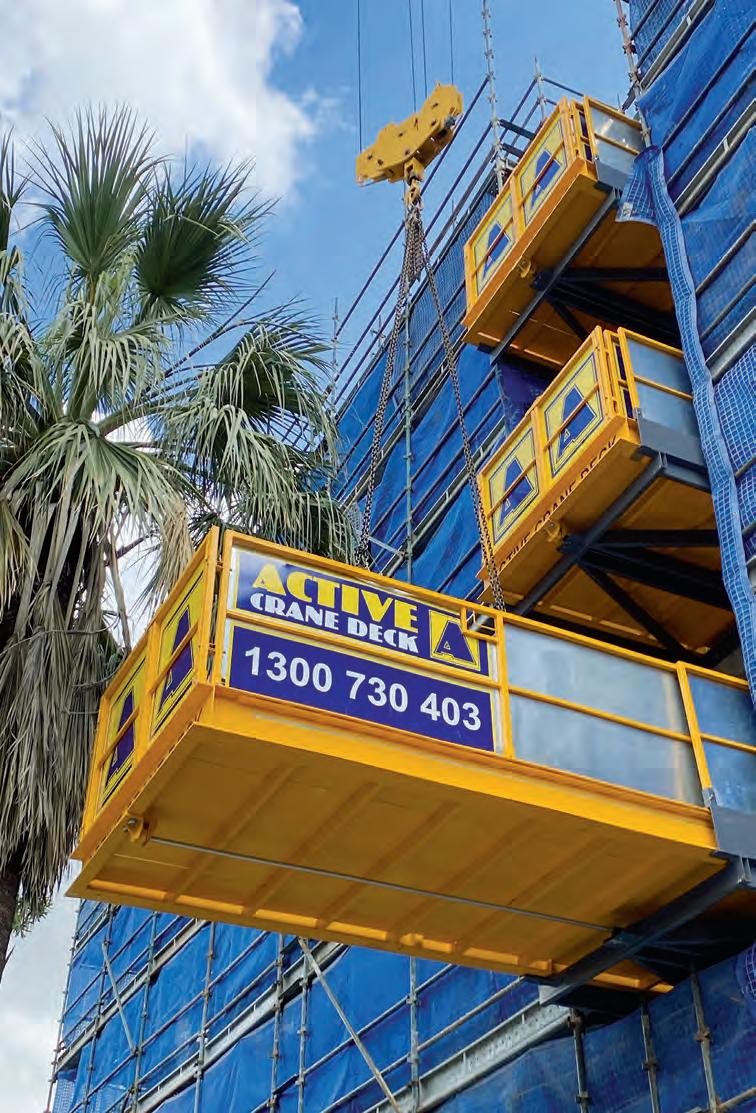
8 minute read
Hydraulic loading decks gain immediate acceptance
A HIVE OF ACTIVITY - ACTIVE CRANE DECK HIRE
Active Crane Deck Hire launched its range of hydraulically operated crane decks with the November/ December issue of Cranes and Lifting. The market’s response has been quick and positive.
HERMANN BUCHBERGER PROVIDES AN
update on the Active Crane Deck product and explains how you really do get what you pay for in an industry where quality and safety are paramount and inseparable.
“We are now manufacturing between 10 and 12 decks per month and this exactly where we thought we would be. We have budgeted for between 100 and 120 decks per year. This means we have 40 decks in stock, and we have forward bookings for 30. These will be delivered to projects in the next two to three months.
“So, to date our supply is meeting the demand but we expect the demand to increase as our marketing of the product increases. We are happy with the launch of the product and how the market has responded so far. The next phase will see the decks tested in the market,” he said.
As with all new concepts and designs there have been some minor issues with the hydraulic decks but this to be expected and were easily fixed says Buchberger.
“We had one or two minor issues relating to hydraulic fittings, which were quickly resolved. We are aware that there will be constant refinements made to the product and we were expecting this.
“The response from the guys using the product has been quick and extremely positive. Because the system is so simple, we haven’t had one question about the operations of the decks.
“We take care of the installation, so the customer basically gets handed the finished product. As we do with our cranes, we visit the site and measure everything. We get the decks to site, install them and hand over everything to the client. It takes half an hour to install a deck. We have also produced a special induction video which takes three minutes to view and a safety induction video which takes two,” said Buchberger.
Many of the competitive crane loading decks are manufactured in China and with the increases in freight costs, the locally manufactured crane decks are proving to be more competitive.
“A 40 foot container, out of the Chinese factory to the Chinese port, shipped to Botany and then transported to Somersby has gone from $5K to 25K. If you only get six to eight decks in the container, by the time you are landing the decks and factoring in the increased rates of shipment they are costing roughly the same what we make our decks for.
“Of course, we are more expensive than the manual decks on the market but there are numerous benefits to having automated extendable and retractable decks. I doubt any local manufacturer would be able to match our quality and pricing.
“I say this because my colleague and business partner Gerd Altmeyer, has a vast international network of suppliers in the manufacturing sector and I know he is sourcing the best products and components at the best prices. Also, we have set up a facility which is second to none for this type of manufacturing.
These factors provide us with a keen competitive advantage,” he said.
The operators who have been using the automated decks have indicated they are unlikely to want to return to the manual decks says Buchberger.
“We have had very positive feedback from the sites and the crews operating the decks. There is no longer any manual labour required. Within one minute the deck goes out and within a minute it comes back in – fully loaded.
“Our calculations highlight the process with a manual deck extension and retraction normally takes three people up to 10 minutes. With our system, one (1) person can manage the process in 45-60 seconds. In our experience, it is not uncommon for a deck to be extended and retracted between five and ten times a day.
“If you factor in the hourly rate for labour at $60 per hour, and this is cheap, it costs $30 each time you move a deck. So, when you look at the time saving and increased productivity our system offers, it is no wonder major builders are taking a close look at what we are doing,” he said.
The big advantage with the Active Crane Deck system is, that the onsite crane is not needed. With a manual deck, it is normally the crane crew which manages the extending and retracting. If the crane crew is spending 10 minutes working on a manual deck the crane isn’t working and is not productive.
“One guy can manage our system and the crane, and its crew can remain focused on what it is supposed to be doing. Our system has a clear advantage when multiple decks are on a site, and they are all on top of each other. Let’s say the deck on the top floor is loaded. Firstly, they must unload the deck before it can be retracted, and whilst this is happening the top deck blocks all the decks below.
“With our system when the deck is extended you don’t have to unload it, you can retract it with the load. This opens the “airspace” for the decks below which can also be loaded and retracted fully loaded. You can now see the productivity and efficiency gains a site of our decks offers. This is the real game changer,” he said.
At the moment, Active Crane Deck is only renting the decks, and there hasn’t been a lot of exposure for the product. But through the Potain tower crane network there is already interest from abroad.
“Exporting the automatic deck concept is an exciting prospect for us, but the freight costs are pricing us out of the market, at the moment. But it is an opportunity we will keep working

When the Active Crane Deck system the deck is extended, it can be retracted with the load, opening up the deck below which can also be loaded and retracted fully loaded.
Active Crane Deck takes care of the installation, with the customer handed the finished product.

on because there are plenty of tower crane businesses wanting to add crane decks to their business offering. And automating the decks is being seen as a natural progression for the product,” said Buchberger.
“We have a number of projects happening in Sydney including one in Homebush for one of our key customers. We are about to deliver a few decks to a project in Gosford on the Central Coast, North of Sydney. At the end of November, we installed decks into a project in Edgecliff in Sydney’s eastern suburbs. We also have orders for projects in Crows Nest and St Ives, and the list is growing.
“The bigger builders have received our automated decks really well and we are confident it won’t take long for the market to fully understand the benefits of our system. We also have a number of suppliers who provide crane labour only and we are promoting the concept through them too. Obviously, it a system that is ‘kind’ to their men who don’t like pushing a manual deck in and out,” said Buchberger.
Active Crane Decks and Active Crane Hire is also expanding its interstate presence with the appointment of a Queensland Manager. Owen Ainsworth has come from general plant hire and is used to approaching builders with general plant for hire rather than specifically cranes.
“We see that offering decks is not that specialised. They come under the category of general plant hire along with bins, generators or concrete kibbles, it’s not very specialised in fact it is quite a common commodity for builders. So, at the moment we are building stock. There is nothing worse than creating demand for a product and then not being able to supply.
“We are also seeing the competition react to our market entry by reducing the rates on the manual decks. We expected this. When you have an innovative product, it is always seen as being the most expensive, therefore you must sell the advantages and the features and benefits of the product. Overall automated decks are a much more economical solution. As we see ourselves to be innovative leaders we are used to that sales process – It is in our DNA.
“Again, it comes back to the three guys taking 10 minutes to move a manual deck where our system requires one guy for a minute and without the onsite crane having to be in idle and then factor in our weekly of premium of maybe $50 and you can see why we have the interest from the big builders,” he said.
“There is also a huge occupational health and safety aspect to our automated system. Manually handling decks causes issues like sore backs, there’s chances of fingers getting caught and there can be major problems and delays when a deck jams. We think the bigger builders will be very comfortable with our product and won’t be put off by the slight premium which comes with it.
“We are also looking to add more specifications to the decks including features like flashing lights, if such are required, when the decks are in operation. The bigger builders may well require these to meet the increased safety standards being rolled out across their sites. We are keen to listen” said Buchberger.
The crane deck market is unregulated. It is not like the crane sector where there are requirements to meet Australian Standards. Insurers and Financiers wanted to know what standards are relevant to crane deck compliance. It turns out there something of a hybrid standard involving elevated work platforms, crane, mechanical, hydraulics and electrical standards. This is where Matthew O’Hearn assisted by overseeing the complete project from an engineering perspective.
“In our opinion, you don’t find many products in construction that tick as many boxes as our automated decks, and where the builder, subcontractors and Site Safety Teams are the real beneficiaries. If the crane crew is freed up and we also free up the crane time, it means the builder should be able to build quicker. We are also increasing safety, productivity and efficiency in the building process so there are multiple plusses with Active Crane Decks,” said Buchberger.










